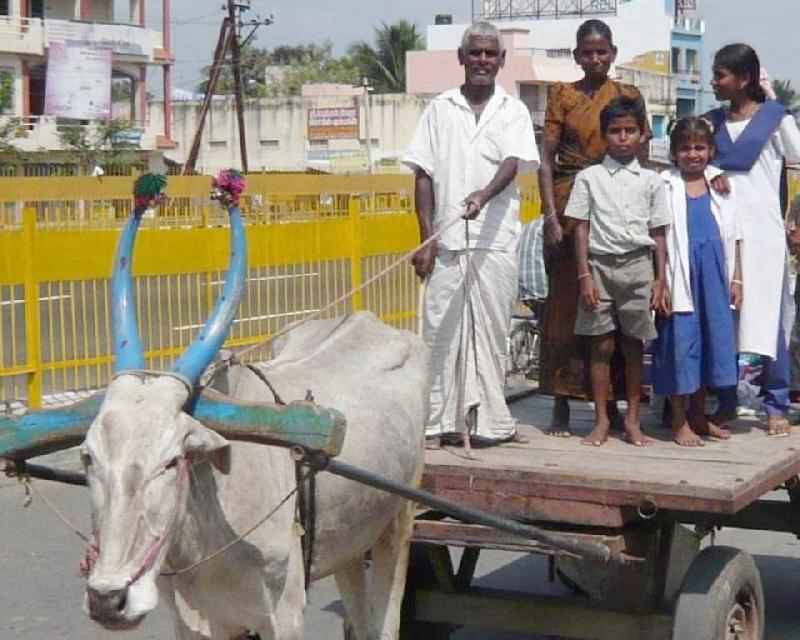
Indian School Activities: Coming and Going to School

Figure 1.--This photograph was taken in Tamilnadu (south-eastern India). It shows a family group with its oxcart. I think they are on their way to school. The children are wearing their school uniforms. The little girl wears a primary school uniofrm while her older sister a secoindsary school uniform.
|
|
We see Indian students coming and going to school. Most children walk to school, especially primary school children. India has a very youthful population with a very large number of children going to school. Thus Indians streets and roads are full of school children in the morning and afternoon. and around noon as many schools are on half-day schedules. There are many other ways of course and some And there are some unquely Indian ways of getting to school. We see children in jitty cabs. We notice quite a number of jitnies, especially at private schools. And here a bullock or ox draws a flatbed waggon with a family and the children all ready for school (figure 1). There are ox carts even in the city. Secondary school studets were less likely to live in walking distance of their school. School busses are not very common as far as we can tell, even in rural areas. And only a few children are driven to school in the family car. For some reason, bicycles do not seem all that common.
We see Indian students coming and going to school. Most children walk to school, especially primary school children. India has a very youthful population with a very large number of children going to school. Thus Indians streets and roads are full of school children in the morning and afternoon. and around noon as many schools are on half-day schedules. There are many primary schools scattered all over rural India, although the small one-room scholols so common in America are unknown. As a result, most children do not have long distances to walk. There are many schools abnd the countryside is often substantially populated. Mother sometimes walk the younger children to school. Many Indian families are large and thus the older children commonly help the younger children to school.
Jittny Cabs
There are many other ways of course and some And there are some unquely Indian ways of getting to school. We see children in jitty cabs. We notice quite a number of jitnies, especially at private schools.
Animals
Here a bullock or ox draws a fl atbed waggon with a family and the children all ready for school (figure 1). There are ox carts even in the city. Secondary school studets were less likely to live in walking distance of their school.
Busses
School busses are not very common as far as we can tell, even in rural areas.
Cars
And only a few children are driven to school in the family car.
Bicycles
For some reason, bicycles do not seem all that common.
HBC-SU

Related Chronolgy Pages in the Boys' Historical Web Site
[Late 19th century]
[The 1930s]
[The 1940s]
[The 1930s]
[The 1940s]
[The 1950s]
[The 1960s]
[The 1970s]
[The 1980s]
Related Style Pages in the Boys' Historical Web Site
[Long pants suits]
[Knicker suits]
[Short pants suits]
[Socks]
[Eton suits]
[Jacket and trousers]
[Blazer]
[School sandals]
Navigate the Boys' Historical Clothing Web Page
[Return to the Main Indian activities page]
[Return to the Main Indian school uniform page]
[Return to the Main Indian country page]
[Introduction]
[Activities]
[Biographies]
[Chronology]
[Cloth and textiles]
[Clothing styles]
[Countries]
[Topics]
[Bibliographies]
[Contributions]
[FAQs]
[Glossaries]
[Images]
[Links]
[Registration]
[Tools]
[Boys' Clothing Home]
Created: 3:53 AM 8/8/2009
Last updated: 11:49 PM 6/26/2011




